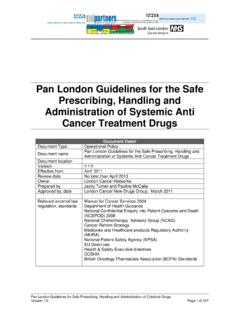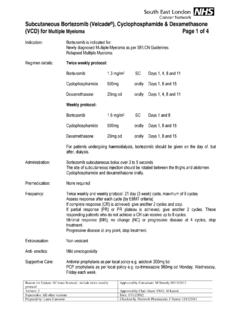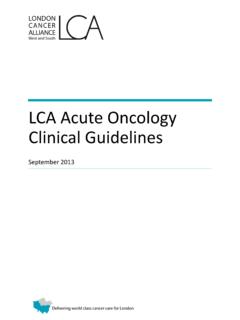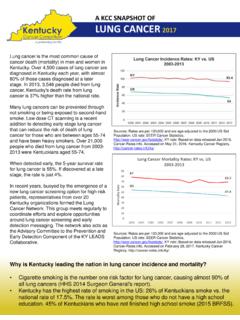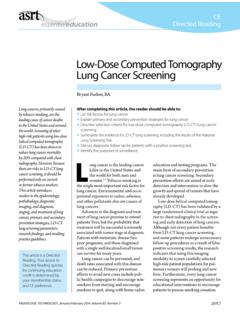Transcription of LA Lung ancer linical Guidelines - London Cancer Alliance
1 LCA Lung Cancer Clinical Guidelines December 2013 LCA LUNG Cancer CLINICAL Guidelines 2 Contents Introduction .. 5 Executive Summary .. 7 1 Prevention .. 9 Background information .. 9 Smoking cessation services .. 9 Implementation of smoking cessation guidance .. 10 2 Early Diagnosis .. 11 Standards to improve early diagnosis for lung Cancer .. 11 3 Referral and 12 Referral for suspected lung Cancer .. 12 Assessment of patients with possible lung Cancer for investigation .. 14 Diagnostic investigations .. 15 Staging investigations .. 16 Staging of lung Cancer .. 18 4 Radiology .. 20 Routine indications for imaging .. 20 5 Pathology Guidelines for the Reporting of Lung Cancer .. 23 Biopsies for lung Cancer .. 23 Lung resection for tumours .. 23 Cytology specimens for lung Cancer .
2 23 Referral of difficult cases .. 24 Molecular analysis .. 24 6 MDT Membership and Function .. 25 7 Data Requirements of Lung Cancer Services .. 26 The Cancer Outcomes and Services Dataset (COSD) .. 26 National Audits National Clinical Lung Cancer Audit (LUCADA) .. 26 Systemic Anti- Cancer Therapy (SACT) chemotherapy dataset .. 26 National Radiotherapy Dataset (RTDS) .. 26 National Cancer Waiting Times Monitoring Data Set .. 27 Local data requirements .. 27 8 Breaking Bad News .. 28 Advance preparation .. 28 Build a therapeutic environment .. 28 Communication .. 28 Dealing with reactions .. 28 CONTENTS 3 9 Inter-professional Communication between Secondary and Primary Care .. 30 General principles .. 30 At diagnosis .. 30 MDT discussions and decisions .. 31 Letters from clinics.
3 31 Treatment Record Summary .. 31 10 Surgical Guidelines .. 32 Introduction .. 32 Non-small cell lung Cancer .. 32 Risk assessment for surgery .. 32 Enhanced recovery after surgery (ERAS) .. 34 Lymph node management .. 34 Adjuvant therapy .. 34 Bronchopulmonary carcinoids .. 34 Small cell lung Cancer .. 35 Post-operative follow-up .. 35 LCA high-quality lung Cancer surgical service measures and metrics .. 36 11 Non-surgical Management of Early Stage Non-small Cell Lung Cancer .. 38 Stereotactic ablative radiotherapy .. 38 Patient selection .. 38 Patient information and consent .. 39 Radiotherapy localisation imaging and 39 Selection of optimal plan .. 41 Dose schedules .. 44 Treatment verification and delivery .. 44 Patient management during and following treatment.
4 44 Percutaneous thermal tumour ablation (PTTA) .. 45 12 Management of Locally Advanced Non-small Cell Lung Cancer .. 46 Radical concomitant chemo-radiotherapy/sequential chemo-radiotherapy/ radiotherapy alone .. 46 Patient selection .. 46 Chemotherapy schedule .. 46 Radical radiotherapy .. 47 Patient management during and following treatment .. 47 13 Management of Metastatic Non-small Cell Lung 48 First-line chemotherapy .. 48 Second- and third-line chemotherapy .. 49 LCA LUNG Cancer CLINICAL Guidelines 4 Palliative radiotherapy .. 49 Follow-up of patients after treatment with palliative intent .. 50 14 Management of Small Cell Lung 51 Introduction .. 51 Limited stage disease .. 51 Extensive stage disease .. 52 15 Supportive and Palliative Care .. 53 Key stages for consideration of palliative care needs.
5 53 Specific therapies .. 55 16 The Lung Cancer CNS/Key Worker .. 60 Team membership .. 61 Patient information .. 61 Holistic needs assessment .. 62 17 Lung Cancer Survivorship Guidelines .. 63 Discuss a person s needs.. 64 Provide a treatment summary and care plan .. 64 Provide a main contact .. 64 Identify post-treatment symptoms .. 65 Provide support about day-to-day concerns .. 65 Talk about how you feel .. 65 Healthy lifestyle .. 65 Self-managed follow-up .. 67 Encourage survivors to share their experience .. 68 Appendix 1: Urgent Suspected Lung Cancer Referral Forms .. 69 Appendix 2: Systemic Anti- Cancer Therapy in Lung Cancer .. 73 Appendix 3: SCLC Chemotherapy Regime Oral Etoposide .. 74 Appendix 4: Radiotherapy: Radiotherapy Normal Tissue Delineation and Tolerances for Radical Treatment.
6 75 Appendix 5: Competencies for Key Worker Role .. 76 Appendix 6: LCA Key Worker Policy .. 78 Appendix 7: LCA Holistic Needs Assessment Tool .. 81 Appendix 8: NCSI Treatment Summary .. 82 Appendix 9: Lung Pathway Metrics .. 85 Appendix 10: Treatment of Teenagers and Young Adults .. 86 88 References .. 90 Acknowledgements .. 92 INTRODUCTION 5 Introduction Lung Cancer is the most common cause of death from Cancer for males and the second most common cause of death for females (after breast Cancer ). The annual incidence of lung Cancer in South East England is per 100,000 among men and per 100,000 among women (average standardised incidence rates, 1999 2003, Thames Cancer Registry). Mortality rates are almost as high, at per 100,000 for men and per 100,000 for women (average standardised mortality rates, 1999 2003, Thames Cancer Registry).
7 Survival from lung Cancer is poor, with less than 10% of patients surviving more than 5 years. The best chance of cure is with early diagnosis and surgery, but as it is so strongly related to smoking, no Guidelines can be written without considering prevention and ensuring that all clinicians take the opportunity to give advice on smoking cessation, particularly to patients referred and reassured through the 2 week wait pathway. The National Lung Cancer Audit has been in place since 2006, and now that most Trusts are reliably entering data, it allows for an earlier comparison of surrogates for survival through data on the proportion of patients receiving potentially curative or active treatment. It is therefore salutary to note that, in 2011, of patients with stages I and II non-small cell lung Cancer , the percentage treated surgically varied between 21% and 62% depending on the Trust of diagnosis, for Trusts seeing at least 20 patients in this group.
8 If the London Cancer Alliance (LCA) were to be able to increase the percentage of these patients treated surgically to that of the best-performing Trust in this audit, then an additional 11% of patients in this group would receive surgical treatment. For small cell lung Cancer , there is a similar variation: the proportion of patients treated with chemotherapy according to Trust at presentation varies between 50% and 76%, for Trusts diagnosing at least 20 such patients per annum. While there may be many reasons for these differences, the LCA needs to be assured that all patients are being diagnosed and staged in an agreed timeframe and managed to the same standards hence the need to have LCA-agreed Guidelines for the treatment of lung Cancer . Prior to the establishment of the LCA, the needs of lung Cancer patients were managed and supervised by three Cancer networks north west, south west and south east London .
9 The LCA Lung Cancer Clinical Guidelines have combined the best aspects of the Guidelines of the three networks, and have been updated to reflect changes and developments in practice. The LCA Guidelines are designed to be used by all healthcare professionals in Trusts within the LCA who are involved in the care of the lung Cancer patient. They have been developed to take into account the wide range of clinical experience of the user and the different clinical settings in which they work. The Guidelines are intended to assist in the initial assessment, investigation and management of patients. Adoption of the LCA Guidelines will allow widespread implementation of up-to-date and evidence-based management of lung Cancer patients, and will assist in the provision of a consistently high standard of care across the LCA.
10 All Trusts are expected to be able to provide the standard of care detailed in these Guidelines . These Guidelines will be reviewed on an annual basis in line with guidance from the National Institute for Health and Care Excellence, the British Thoracic Society, and other national and international guidance, as well as significant new research publications, to ensure that they continue to reflect best practice. Please note that this set of Guidelines is limited to small cell, non-small cell lung Cancer , and carcinoid. Separate clinical Guidelines will be developed for mesothelioma and thymoma. LCA LUNG Cancer CLINICAL Guidelines 6 Please also note that treatment for patients from the age of 16 to their 25th birthday should be in line with national guidance regarding the management of teenagers and young adults with Cancer .







